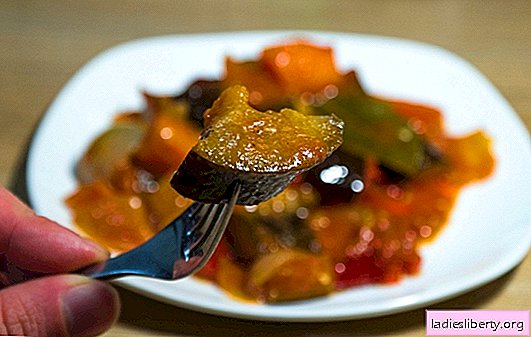
Someone loves dishes with beans, but does not cook them often, because beans require time for soaking, long cooking, and time is appreciated expensively by modern women. There is always a way out of any situation. In the case of beans, you need to spend one day a year to harvest it, so that you save time on cooking your favorite dishes for a whole year. In addition, fresh beans have a more delicate shell, which greatly simplifies the cooking process, in comparison with dry beans, which have a very dry and hard shell.
Most of the summer bean preserves in tomato in the winter can be used as an additional ingredient for soups and borsch, as independent side dishes for meat dishes.
We preserve beans in tomato sauce - the main technological features
The main feature of bean preservation is the choice of raw materials. Beans for canning are collected in the stage of milk ripeness, when they have a soft shell, and the grains can be easily crushed with fingers. This requirement applies to all bean varieties. Therefore, it is best to collect canning beans in a summer cottage, and immediately proceed to their conservation, since within 12 hours after collection they dry out, losing their softness.
Dry bean grain not only requires long cooking, but also acquires other properties during storage - the coarse shell increases the content of carbohydrates that cause fermentation, which increases the time for preliminary preparation of beans for canning and shortens its storage time. Hard grains are boiled until soft, washed thoroughly with hot boiled water, and only then proceed to their further processing.
The easiest way to harvest beans, green peas, sweetcorn is with an autoclave, but not every home has such a device. All the same fermentation complicates the conservation process. In addition to carbohydrates, these vegetables also contain a large amount of protein, which is fraught with bloating cans, if canning technology is not carefully observed. The only way to preserve the harvest in banks is to thoroughly prepare the beans. It is known that microorganisms that cause fermentation die during dehydration, prolonged sterilization at high temperature, and when the acidity of the medium in which they are located changes.
In addition to the standard requirements for home preservation, beans are sterilized at temperatures above 100 ° C. Such sterilization conditions in a home environment are difficult, but possible. Modern kitchen appliances can provide such a temperature. In extreme cases, you can resort to a simple method: sterilize the jars of beans in a conventional oven at a minimum level, as for baking protein dough, at a minimum temperature. Only after sterilization of the cans do not rush to get them out of the oven so that they do not burst from a sudden change in temperature. To avoid cracking, place the jars on a pan filled with water. But water, evaporating during boiling, should not settle in the form of steam on the surface of filled cans. Therefore, you need to put filled cans in the oven only when closed. It is even advisable to use cans with screw threads for the lids, which must be screwed almost tightly so that when the air exits from the inside, the vapor cannot penetrate inside the can. After cooling, the lid will be tightly attracted to the jar, the vacuum formed inside the jar. It remains only to check the quality of the capping and, if necessary, screw the lid more tightly. You need to do this while the jar is still hot enough.
Now about the optimal acidic environment in which the beans should be after canning. Again, we turn to scientific knowledge that must be put into practice. The growth and development of bacteria inhibits excess sugar or salt. These substances dehydrate microorganisms. But what if you don’t need beans in a tomato, neither too salty, nor, especially, very sweet? Gently add salt and sugar to taste, and to avoid unnecessary losses and hassle, use ordinary table vinegar, just add it at the very last moment, pouring on the surface of the beans in a jar, and the germs - the end!
There is another way to combat microorganisms, it is used in industry, when preserving in autoclaves not only legumes, but also fish and meat. In the raw materials intended for canning, pour brine, sauce, broth or marinade, with the addition of sodium chloride. This salt has an antiseptic effect and at a concentration of 8-12% in solution it completely inhibits microorganisms.
Sodium salt does not have a pronounced taste, and therefore canned foods do not seem to be saline. For humans, this salt is safe, but in home canning, in the absence of an autoclave, sodium chloride solution can be used only at the stage of preliminary processing of beans, as a disinfectant. With ordinary home pasteurization, a solution of this salt can be added to the sauce. Ready-made solution can be purchased at any pharmacy. You can also, without adding sodium chloride to canned beans, use a solution for pre-boiling beans, and prepare tomato sauce with the addition of vinegar, sugar and table salt, as usual.
1. Canned beans in tomato sauce - preparation for first courses and side dish
Ingredients:
Tomatoes 3 kg
Young beans 1.5 kg
Garlic 10-12 cloves
Chile, green 2 pcs.
Granulated Sugar 140 g
Salt 80 g
Vinegar 60 ml
Cooking:
Take the young beans, fill with water, add a little salt and put to cook. When the beans are completely ready, drain the water. Make sure that it does not boil. Ready beans are easily pierced with a fork, soft. Peel the garlic and pepper, and mince them with prepared tomatoes through a meat grinder. You should have a slightly thick sauce. To keep its consistency smooth, wipe through a sieve, removing the grains and peel of vegetables. Add sugar and salt, and simmer for 10 minutes. Pour the sauce into the beans, cover and simmer for about an hour. In the meantime, pasteurize half-liter jars over steam, and the lids in boiling water. Put the beans in jars, pour the vinegar separately into each jar, and roll them up. Then turn the jars over and wait until they cool. Store canned beans in a dark and cool place.
2. How to preserve beans in tomato sauce with eggplant
Ingredients:
Boiled Beans 800 g
Ripe tomatoes 3.6 kg
Onions 600 g
Bell pepper 500 g
Carrot 600 g
Eggplant 400 g
Oil 200 ml
Refined sugar 60 g
Cloves, coriander, paprika
Vinegar 75 ml
Salt 50 g
Cooking:
Chopped peeled carrots coarsely, chop onions. Fleshy salad pepper and peeled eggplant, cut into cubes. Fry the prepared vegetables separately, with the addition of vegetable oil.
Blanch the tomatoes and rub the pulp. Put all the vegetables in the pan along with the beans. Pour in tomato puree, salt, add sugar and cook for about an hour, mixing everything thoroughly. Ready-made tomato sauce has a thick consistency. Season with spices, add vinegar at the end of the stew. Pack the prepared beans and vegetables in prepared jars, and roll them up. Place the cans upside down, before cooling.
3. Canned beans in tomato sauce, spicy with mushrooms
In the middle zone, the ripening season of beans coincides with the rich harvest of chanterelles in the forest. If during the "silent hunt" lucky to pick up a basket of mushrooms, prepare a delicious side dish for the winter. If there are no chanterelles, you can replace them with other forest mushrooms or champignons. In the southern regions, beans have time to ripen twice, so the second harvest coincides with the season of autumn mushrooms, the most delicious mushrooms, if you fry them.
Ingredients:
Tomatoes 3 kg
White beans 1.5 kg
Garlic 90 g
Red chili 3 pcs.
Sugar 140 g
Salt 80 g
Table vinegar 150 ml
Fresh dill
Bay leaf
Refined sunflower oil 250 ml
Onion 1.0 kg
Mushrooms 3 kg
Cooking:
Boil the beans until cooked, but do not allow them to boil. It should be slightly stiff. Peeled garlic, pepper with prepared tomatoes through a meat grinder. Wipe through a sieve to make mashed potatoes. After adding sugar and salt, simmer tomato sauce 10 minutes before thickening begins. Boil the prepared mushrooms and fry with onions, adding vegetable oil to the pan. Season with spices. Combine the mushrooms with boiled beans, pour the cooked tomato sauce, cover, cook for about an hour.
Pour into prepared jars, pasteurize for 20 minutes (0.5 L), close immediately. Turn the cans over, cover and let cool.
4. Canned beans in tomato sauce "Garden on the table"
Product Composition:
Boiled Beans 800 g
Onions 600 g
Cauliflower 1.2 kg
Tomatoes 3 kg
Bell pepper 500 g
Salt 40 g
Carrot, red 600 g
Oil 300 ml
Sugar 90 g
Vinegar 50 ml
Cooking:
Chop the peeled carrots or cut into medium-sized bars, and chop the onions into medium-sized cubes. Blanch cabbage inflorescences in salted water, adding laurel leaves, celery or parsley roots, and ground spices to taste. Pass the onions and carrots until tender. Dice the peppers, passer or bake the whole in the oven, and then, after peeling and removing the seed, wipe together with the blanched tomatoes to a puree state. Rinse boiled beans thoroughly and fold through a sieve. Combining all the prepared ingredients, salt, add sugar, and set to boil for about an hour, thoroughly mixing everything. Put the mass in banks, and roll up. Turn the cans upside down, wrap them, and let stand until cool.
5. Red canned beans in tomato sauce
Products:
Beans, young 1 kg
Tomatoes 3 kg
Pods of peppers, hot 2 pcs.
Allspice
Clove
Cilantro (or ground coriander)
Ground cumin
Bay leaf
Salt 70 g
Granulated Sugar 120 g
Vegetable oil 100 ml
Vinegar 150 ml
Cooking:
Boil pre-soaked beans and drain the water. Grind hot peppers to a pasty consistency. If you want to reduce the severity of the dish, first remove the grains. Use gloves.
Blanch tomatoes, mash. After adding mashed pepper, all the spices and oil, cook the sauce at a low temperature for 10 -15 minutes. Pour the beans with the prepared sauce and put on low heat for half an hour. In the process of cooking, add a few leaves of bay leaf, adjust the taste. Lay the prepared beans in jars hot, pasteurize: jars 0.33 l and 0.5 - 10 minutes; 0.7 L - 20 minutes.
6. Canned beans in tomato sauce with garlic
Ingredients:
Beans, white 2 kg
Tomato Puree 2.5 L
Garlic 1 large head
Cilantro and parsley (fresh leaves) to taste
Olive oil 350 ml
Salt, sugar, pepper
Vinegar 250 ml
Cooking:
Sort the beans and cook until cooked, being careful not to boil it. Rinse with running water, pour over boiling water and drain the water. Grind fresh herbs, garlic. Combine chopped greens with beans, add spices and mix. Combine the tomato puree with butter and bring to a boil. Add the beans to the sauce, boil for 10-15 minutes. Add vinegar to the beans at the very end of cooking, and immediately pack in hot and dry sterile jars. Screw the lids on and put the cans in the oven, preheated to 120 ° C for 15 minutes. Leave the cans in the oven until completely cooled after turning off the oven. Check the quality of the capper.
How to preserve beans in tomato sauce - useful tips
For preservation, carefully sort the beans, they must be the same size, you can not mix different varieties of beans in one batch of blanks.
Red beans have a more pronounced taste, and white beans have a neutral taste. Other varieties of beans differ in taste and aroma. This feature must be taken into account by combining beans with other vegetables in one jar and using all kinds of spicy aromatic additives.
Pay attention to the shape and size of the sliced vegetables, take into account the method of their heat treatment, trying to imagine how appetizing the cooked dish will look after long cooking and storage. Vegetables of the same density should have the same size. This will provide them with a beautiful appearance and the same degree of readiness.
Do not try to chop onions, peppers or carrots too thinly: after prolonged cooking, stewing, stewing, pasteurization, these vegetables will turn into an ugly boiled mass, in which dense beans are added. If soft vegetables were accidentally overcooked, it is better to wipe them through a sieve and add to tomato puree.











